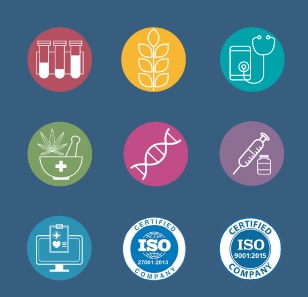Introduction
The pharmaceutical and medical device industries are facing numerous challenges during their production life cycle.
One of the most complex challenges that need to be dealt with is the stage of subcontractor approval – where your production relies on others.
Imagine a production line where one of the raw materials suddenly runs out.
What will you do? How will you deliver your product to the market?
The supply chain is the network of all individuals, organizations, resources, activities, and technology involved in creating and selling a product.
The supply chain encompasses everything from material delivery from the supplier to the manufacturer and then final product delivery to the end-user.
Below we will be introducing a specific case study. It describes how our customer (a medical device company) overcame a crisis when their supplier informed him that he would no longer be able to supply a small raw material – one of the device’s crucial electrical components.
Case study
RS-NESS was asked by the customer to carry out, amongst other things, business-critical continuity projects. A business-critical continuity project is when it is mandatory to have continuous production carried out immediately after validation and manufacturing process approval due to strong market demand.
Please let me stop for a moment and describe how the “butterfly effect” is well reflected during the production process.
A manufacturing company that assembles products relies on the components’/raw material’s suppliers. The supplier depends on the manufacturer.
However, once the manufacturer is no longer able to supply the exact part, he will try to provide a similar part or a very similar part but using a different raw material.
The supplier should update his client immediately and as close as possible when this part/raw material runs out (including time and date).
From this point onwards, a reaction chain begins, which significantly influences the next player in the chain. The manufacturer will ultimately demand to find an alternative supplier, to perform a comparative study, process validation, and the replacement component’s approval.
It is mandatory as well to update and re-approve the technical file according to regulatory requirements.
Going back to my story:
The supplier informed our client about the missing critical component as an “out of stock” part – which ultimately initiated our project:
The engineering department had to find an appropriate alternative replacement; however, more work had to be done to comply with regulatory requirements.
Accordingly, the next steps required were to:
- Perform a Risk Analysis- adding evaluation of new risks;
- Write the Validation Master Plan (VMP);
- Write the Validation Protocols and Assembly Instructions.
In addition to the above list, the following points were noticed:
- The gluing process of the new component required a different adhesive, shortening the drying time.
- The new alternative component required new wiring, which was found to be finer, and therefore further adjustments were needed to be implemented into the manufacturing line.
- The existing equipment was suitable for thick wires; therefore, it was necessary to order new components and adjust them for the new wires.
This appeared to be the easy part!
Upon equipment adjustment completion, a new problem arose: the percentage of rejected sensors on the manufacturing line increased dramatically.
An investigation was launched in order to identify the root cause.
It was finally discovered: the latches were not secured to the correct point on the wires, which lead to electrical failures in the downstream assembly process.
Following our findings, a microscope was integrated into the manufacturing line to help operators attach the clips to the thin wires accurately.
We succeeded in reducing the percentage of invalid wires; however, on the other hand, the production rate was not sufficient due to the assembly line’s high precision requirements.
This rate will increase over time- this is known as experience.
Once we found a way to reduce the failure percentage, we had to:
• Define what is considered an “invalid wire”
• Establish “up-to-date” work instructions for the wire’s winding clamps.
Fortunately, the assembly workers, encouraged by their direct managers, were happy to improve the production processes.
After ensuring that an acceptable rate of failures during the assembly process was achieved, we moved to the “core” of the project- the project planning and validation stage approval. Good communication was vital at this stage since tracking the performance of the V&V activities (making sure its priority was as high as possible) was critical to ensuring we were on track with the pre-determined schedule. Prior to the Validation and Verification (V&V) stage- one big obstacle must be avoided: mix-up at the production line!
Mix-up is a nightmare for all of the operation parties- quality and production. In addition to the immediate damage of losing time and deviating from the goals to solve the problem, Mix-ups cause secondary damage of loss of trust and suspicion, blaming, and loss of reputation. The client I worked with developed a method for minimizing the frequency of this phenomenon as much as possible.
As a member of the Engineering Department and as an employee of an external (consulting) company, there was a greater responsibility on me to prevent as many mix-ups as possible. I closely monitored the special production for the validation phase and then transferred the products to the validation department for execution.
The project was finally completed successfully, and the new component was assimilated into the production lines.
We have learned from this scenario that in order to connect all the puzzle pieces of the project, the critical factors for success are: cooperation and motivation!
My advice to you
Adopt a good communication method and a lot of patience to become a successful professional actor. It will also help you manage time-consuming actions for the future.
RS NESS is a service provider and consulting company in the Life science industry for those who are unfamiliar with us.
RS NESS provides a variety of services such as project management, quality assurance, regulatory affairs, clinical affairs, validation and engineering services.
As an employee at RS NESS, in addition to our academic knowledge and practical training, we have been gifted by the ability to learn and adapt quickly, to combine our expertise with flexibility in order to provide the most professional service to our customers.
If you have any questions, or if you need professional support, please contact us.
About autor

Roei Aricha
Engineering Project Manager
Roei has over 10 years of experience in the Lifescience industry. Roei is serving the company as a project manager and validation engineer for over three years. He participated in and led dozens of projects. He brings with him extensive knowledge in the fields of engineering, validations, and project management.
Roei earned a Bachelor of Science degree in Pharmaceutical Engineering from the Jerusalem College of Engineering, Jerusalem, Israel.



















